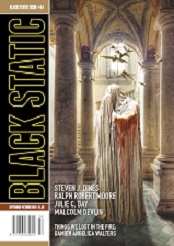 Black Static #54, September/October 2016
Black Static #54, September/October 2016
“Perspective” by Steven J. Dines
Reviewed by Benjamin Wheeler
The 54th issue of Black Static has three novelettes and a short story.
“Perspective” by Steven J. Dines
In this novelette, psychosomatically blind Emily Knight is being stalked by a pervert, the same one who raped her years ago. She hides from reality in a field she imagines inside her head, a construct that will certainly never harm her. Her husband, David Knight, is a bank manager who dreams of being fired though he actively continues to work. He is frustrated by her inability to face reality. Throughout this, the man who raped Emily is watching them from windows. David confronts the pervert Dullicut on Emily’s demands.
The title is meaningful to the story. Every major character but Dullicut has a ‘perspective’ chapter. Each one has a warped view of reality. Emily can’t face reality at all. David is unsatisfied with his wife and life, and has white knight fantasies besides. The pervert believes he owns Emily. Dullicut watches children, and remembers his brother, who died when he was eight. Throughout, there are callbacks to Emily’s past, and descriptions of what happened to her. I was dissatisfied by this novelette, as no character tries to overcome what they are, and are stuck in the past. The lack of moving forward is tragic, and leads to tragedy. Emily flings a hot tea kettle at an intruder, and David is on his way home (after a call from Emily regarding said intruder) and may be the one she has attacked. Or, it’s Emily moving forward to overcome her adversity. The writing is unclear as a cheap trick to make one think, but due to the depressing nature of everyone else’s actions, I was not hopeful for a happy ending.
“A Pinhole of Light” by Julie C. Day
Here, Geir’s wife, Veronica, is dead, leaving infant daughter Jenny. Geir can’t let her go and uses photography to try and reach her. He channels ghosts through the flesh of his arms, tattooed with old photographs. Meanwhile, Jenny and her ‘uncle’ Pete are painting the wall of her bedroom with a creepy mural of the town. Eventually, Geir reaches Veronica who tells him he’s pathetic, and that he should let her go. It ends with Geir telling Jenny a story about Veronica.
This is one of the better stories in this issue. The descriptions are spot on and really lent to the gloom of the story. I was very much drawn in by the obsession of Geir, as well as the youthful innocence of Jenny. However, Geir’s obsession took me out by the end. Veronica is not a nice woman at all, and doesn’t seem to care for her daughter or Geir. It’s implied she committed suicide. What makes it most tragic is that Geir, at the end, is not out of the delusion that he desires. Rather he rejects the reality in favor of the delusion, which I found dissatisfying.
“Not Everything has a Name” By Ralph Robert Moore
In this story, Tommy drives main character Sheila to a dive bar for a date. Tommy bets Sheila on a pool game, and loses to Ben. Sheila is taken to Ben’s house and reveals a face in her midsection. After sex, she convinces Ben to help her fight monsters who steal souls. If the two succeed in defeating them, then the face in her midsection will become a real boy. Ben succeeds, and the boy is saved.
This is my favorite story of the four. The descriptions are spot on and the interactions between Ben and Sheila, and by proxy, Tommy, are fantastic. It’s got realistic dialogue and a good grasp on how people really tick. This translates into a real world that gives a high level of creepiness to the monsters. We’ve all seen things in shadows, and the author makes a good show of making those things creepier.
“Dogsbody” by Malcom Devlin
Gil McKenzie turned into a werewolf once. No one knows why he and many, many others turned into something else for a brief time, for no reason known. He thinks it keeps him from jobs and opportunities. During a night of drinking, he meets with Vicki, who he resents because he thinks she denied him a job because he turned into a werewolf. She reveals it wasn’t so and that they had hired a man named Lance, who had turned the same way.
This isn’t too creepy a story, despite being about werewolves. Rather, it discusses the ramifications of a bunch of people randomly being hit by lycanthropy. It was handled well. The social issues are brought out, and people’s answers to it are fairly logical. How can you trust people who have become ‘othered’ through no fault of their own? It turns out that as long as nothing really changes, the main problems are their views of themselves, rather than how others view them. I note that those who would persecute them are shown to be untermenschen of a sort, quite subtly.